Hydraulic machines are defined as those machines which convert either hydraulic energy (energy possessed by water) into mechanical energy (which is further converted into electrical energy ) or mechanical energy into hydraulic energy. The hydraulic machines, which convert the hydraulic energy into mechanical energy, are called turbines while the hydraulic machines which convert the mechanical energy into hydraulic energy are called pumps. In this article Let us discuss the Hydraulic Turbines, Heads, Efficiencies and Classification of these Turbines.
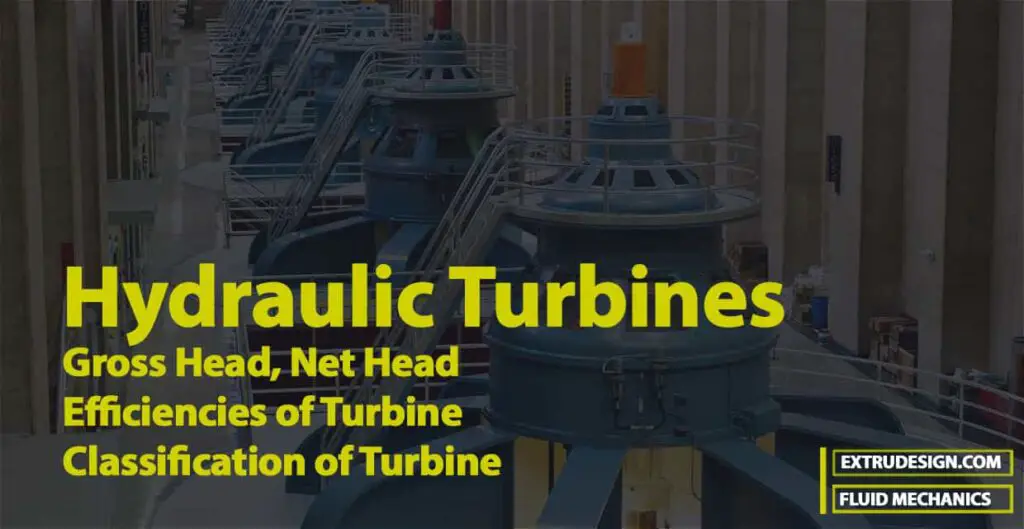
Thus the study of hydraulic machines consists of the study of turbines and pumps. Turbines consist of the main study of the Pelton turbine, Francis Turbine and Kaplan Turbine while pumps consist of the study of centrifugal pumps and reciprocating pumps.
Hydraulic Turbines
Turbines are defined as hydraulic machines which convert hydraulic energy into mechanical energy. This mechanical energy is used in running an electric generator which is directly coupled to the shaft of the turbine.
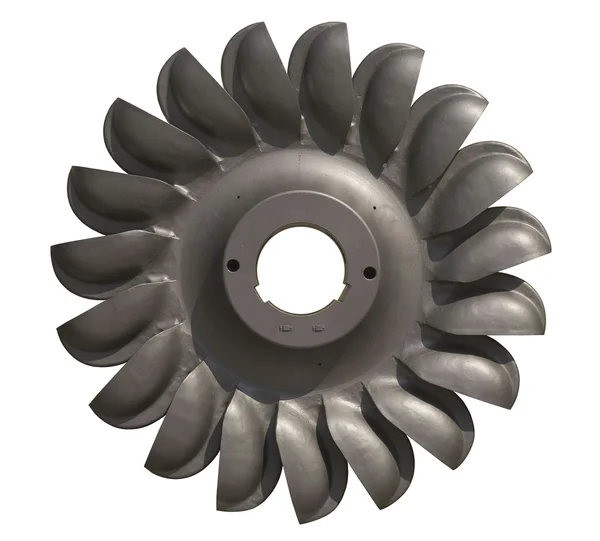
Thus the mechanical energy is converted into electrical energy. The electric power which is obtained from hydraulic energy (energy of water) is known as Hydroelectric power. At present, the generation of hydroelectric power is the cheapest as compared to the power generated by other sources such as oil, coal etc.
General Layout of A Hydroelectric Power Plant
The following figure shows a general layout of a hydroelectric power plant.
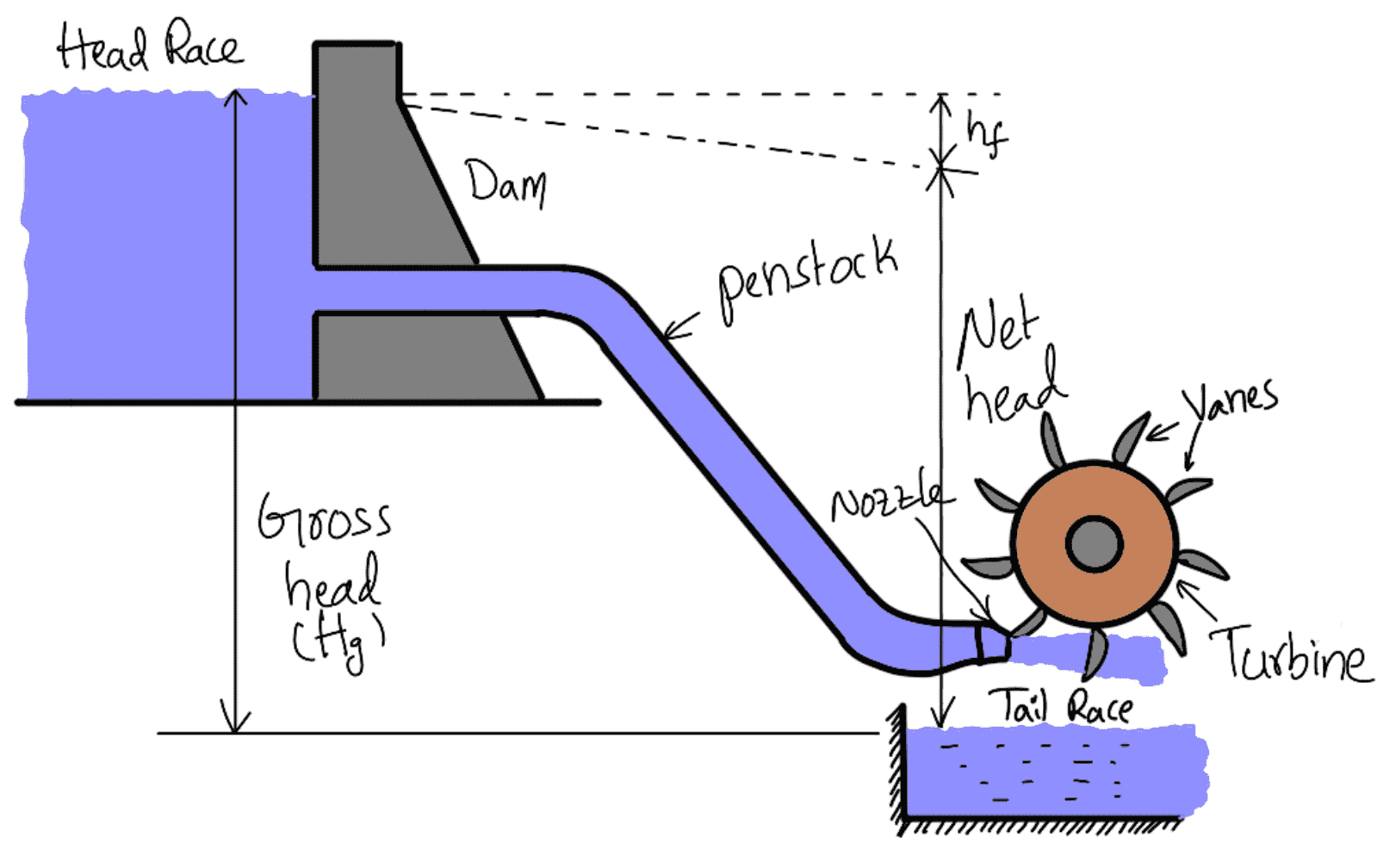
The hydroelectric power plant consists of the following equipment.
- A dam was constructed across a river to store water.
- Pipes of large diameters are called penstocks, which carry water under pressure from the storage reservoir to the turbines. These pipes are made of steel or reinforced concrete.
- Turbines have different types of vanes fitted to the wheels.
- Tail race, which is a channel which carries water away from the turbines after the water has worked on the turbines. The surface of the water in the tail race channel is also known as the tail race.
Definitions of Heads
Gross Head
The difference between the head race level and tail race level when no water is flowing is known as Gross Head. It is denoted by ‘Hg‘ as represented in the above general layout of a hydroelectric power plant.
Net Head
It is also called an effective head and is defined as the head available at the inlet of the turbine. When water is flowing from the head race to the turbine, a loss of head due to friction between the water and penstocks occurs. Though there are other losses also such as loss due to bend, pipe fittings, loss at the entrance of penstock etc., they are having small magnitude as compared to head loss due to friction.
If ‘hf‘ is the head loss due to friction between penstocks and water then the net heat on the turbine is given by
H = Hg – hf
where
Hg = Gross head
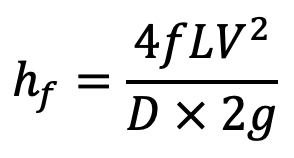
V = Velocity of flow in the penstock
L = Length of the penstock
D = Diameter of the penstock
Efficiencies of a Turbine
The following are the important efficiencies of a turbine
(a) Hydraulic Efficiency, ηh
(b) Mechanical Efficiency, ηm
(c) Volumetric Efficiency, ηv
(d) Overall Efficiency, ηo
(a) Hydraulic Efficiency (ηh)
It is defined as the ratio of power given by water to the runner of a turbine (the runner is a rotating part of a turbine and the runner, vanes are fixed) to the power supplied by the water at the inlet of the turbine. The power at the inlet of the turbine is more and this power goes on decreasing as the water flows over the vanes of the turbine due to hydraulic losses as the vanes are not smooth. Hence, the power delivered to the runner of the turbine will be less than the power available at the inlet of the turbine. Thus, mathematically, the hydraulic efficiency of a turbine is written as

where
R.P. = Power delivered to runner i.e., Runner Power
For Pelton Turbine

For Radial Flow Turbine

W.P. = Power supplied at the inlet of the turbine and also called water power

where
W = Weight of water striking the vanes of the turbine per second = ρg × Q
Q = Volume of water/s,
Vw1 = Velocity of whirl at the inlet,
Vw2 = Velocity of whirl at the outlet,
u = Tangential velocity of the vane,
u1 = Tangential velocity of the vane at the inlet for radial vane
u2 = Tangential velocity of the vane at the outlet for the radial vane
H = Net head on the turbine
Power supplied at the inlet of the turbine in S.I.units is known as water power. It is given by

For water ρ = 1000 kg/m3

The above relation (b) is only used when the flowing fluid is water. If the flowing fluid is other than
the water, then relation (a) is used.
(b) Mechanical Efficiency (ηm) of Turbine
The power delivered by water to the runner of a turbine is transmitted to the shaft of the turbine. Due to mechanical losses, the power available at the shaft of the turbine is less than the power delivered to the runner of a turbine. The ratio of the power available at the shaft of the turbine (known as S.P. or B.P. ) to the power delivered to the runner is defined as mechanical efficiency. Hence, mathematically, it is written as follows.

(c) Volumetric Efficiency (ηv) Turbine
The volume of the water striking the runner of a turbine is slightly less than the volume of the water supplied to the turbine. Some of the volumes of the water are discharged to the tail race without striking the runner of the turbine. Thus the ratio of the volume of the water actually striking the runner to the volume of water supplied to the turbine is defined as volumetric efficiency. It is written as follows.

(d) Overall Efficiency of Hydraulic Turbines (ηo)
It is defined as the ratio of the power available at the shaft of the turbine to the power supplied by the water at the inlet of the turbine. It is written as
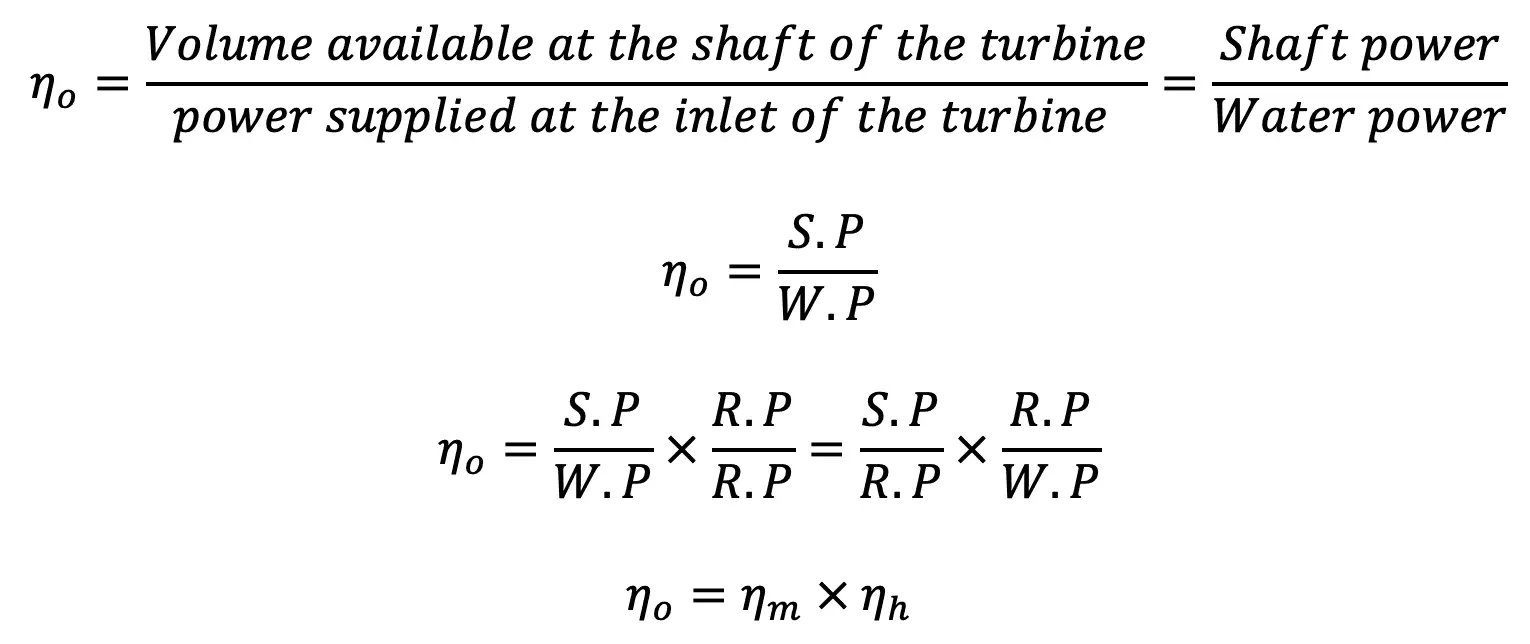
If shaft power (S.P.) is taken in kW then water power should also be taken in kW. Shaft power is commonly represented by P. But from equation (a),
Water power in kW

We can rewrite the Overall Efficiency as follows
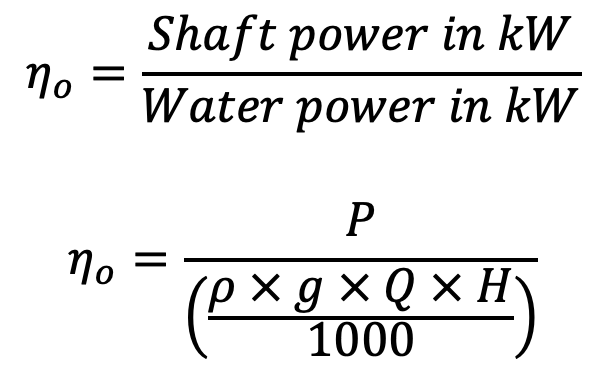
where P = Shaft power.
Classification of Hydraulic Turbines
The hydraulic turbines are classified according to the type of energy available at the inlet of the turbine, the direction of flow through the vanes, the head at the inlet of the turbine and the specific speed of the turbines. Thus the following are the important classifications of the turbines:
- According to the type of energy at the inlet :
(a) Impulse turbine
(b) Reaction turbine - According to the direction of flow through the runner
(a) Tangential flow turbine
(b) Radial flow turbine
(c) Axial flow turbine
(d) Mixed flow turbine - According to the head at the inlet of the turbine :
(a) High-head turbine
(b) Medium-head turbine
(c) Low-head turbine - According to the specific speed of the turbine :
(a) Low specific speed turbine
(b) Medium-specific speed turbine
(c) High-specific speed turbine
If at the inlet of the turbine, the energy available is only kinetic energy, the turbine is known as an impulse turbine. As the water flows over the vanes, the pressure is atmospheric from the inlet to the outlet of the turbine. If at the inlet of the turbine, the water possesses kinetic energy as well as pressure energy, the turbine is known as a reaction turbine.
As the water flows through the runner, the water is under pressure and the pressure energy goes on changing into kinetic energy. The runner is completely enclosed in an air-tight casing and the runner and casing are completely full of water. If the water flows along the tangent of the runner, the turbine is known as a Tangential flow turbine. If the water flows in the radial direction through the runner, the turbine is called a Radial flow turbine. If the water flows from outwards to inwards, radially, the turbine is known as an inward radial flow turbine, on the other hand, if water flows radially from inwards to outwards, the turbine is known as an outward radial flow turbine.
If the water flows through the runner along the direction parallel to the axis of rotation of the runner, the turbine is called an axial flow turbine. If the water flows through the runner in the radial direction but leaves in the direction parallel to the axis of rotation of the runner, the turbine is called a mixed flow turbine.
This is All about the Hydraulic Turbine. Let us know what you think about this article in the comment section below.

Leave a Reply